Tool Search: Special Ed Documents
The Evaluation in Campus is used to document the student's educational needs and determination of eligibility for special education. This document describes each editor, each field on the editor, any special considerations, and instructions for using the editor and fields.
An evaluation must be created whether or not the student is determined to have a disability. The school district gives a copy of the evaluation summary report, including the documentation of eligibility, to the student’s parents. For information on general functionality, navigation, and additional plan and evaluation features, see the core Plan and Evaluation Information article.
The current format of this document is the MT Evaluation Report. Evaluation formats are selected in Special Ed Eval Types.
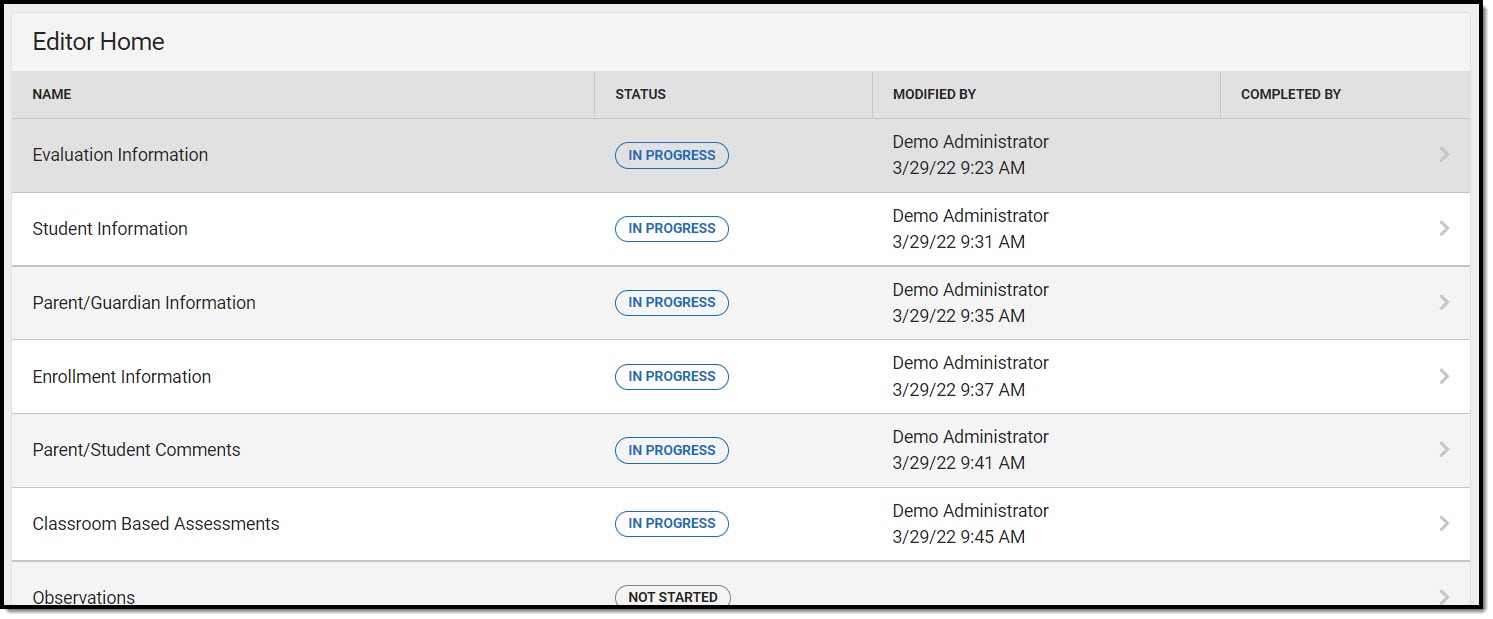 Editor Home
Editor Home
Evaluation Information
The Evaluation Information editor provides basic information regarding the evaluation.
 Evaluation Information Editor
Evaluation Information Editor
| Field | Description |
|---|---|
| Evaluation Date
Required | The date of the evaluation. |
| Evaluation Type | The type of evaluation. Options include:
|
| Date Consent Received
Required | The date the parent/guardian gave consent to evaluate the student. |
Student Information
The Student Information editor displays basic information about the student such as demographic information. This is a read-only editor.
The Refresh button retrieves a fresh copy of data from the student's record. See the General Information section for additional information.
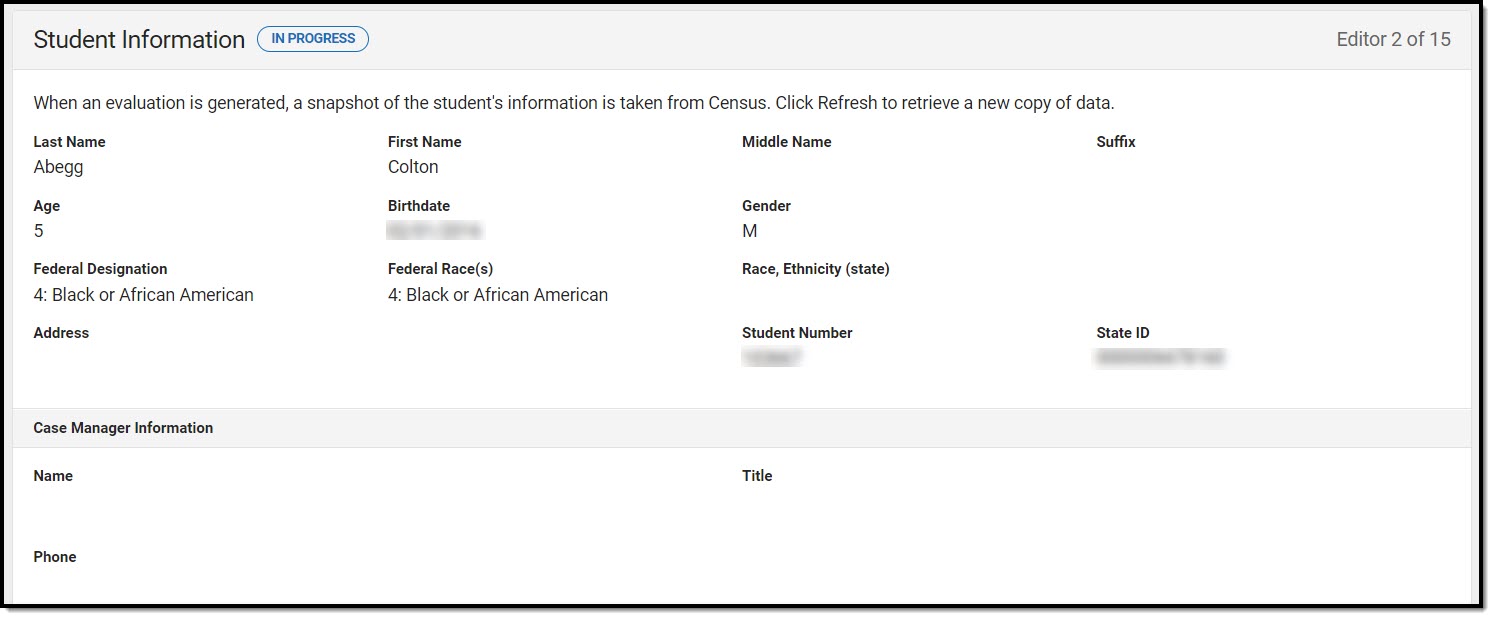 Student Information Editor
Student Information Editor
| Field | Description | Ad Hoc |
|---|---|---|
| Last Name | The student's last name. | Census > People > Demographics > Last Name identity.lastName |
| First Name | The student's first name. | Census > People > Demographics > First Name identity.firstName |
| Middle Name | The student's middle name. | Census > People > Demographics > Middle Name identity.middleName |
| Suffix | The student's suffix. | Census > People > Demographics > Suffix Name identity.suffix |
| Age | The student's age. | Census > People > Demographics > Age identity.age |
| Birthdate | The student's birthdate. | Census > People > Demographics > Birth Date identity.birthDate |
| Gender | The student's gender. | Census > People > Demographics > Gender identity.gender |
| Federal Designation | The student's federal race designation. | Census > People > Demographics > Federal Designation identity.raceEthnicityDetermination |
| Race, Ethnicity (state) | The student's state race/ethnicity designation. | Census > People > Demographics > Race/Ethnicity Determination identity.raceEthnicity |
| Address | The student's address. This field becomes a dropdown when more than one address exists for the student. The primary household displays by default. | Census > Households > Address Info address.number; address.street; address.tag; address.prefix; address.dir; address.apt; address.city; address.state; address.zip |
| Student Number | The student's identification number. | Census > People > Demographics > Student Number |
| Case Manager Information These fields are read-only. | ||
| Name | The first and last name of the team member. | Student Information > Special Ed > General > Team Members |
| Title | The role of the team member. | Student Information > Special Ed > General > Team Members |
| Phone | The phone number of the team member. | Student Information > Special Ed > General > Team Members |
Parent/Guardian Information
The Parent/Guardian Information editor populates based on the guardian checkbox on the student's Relationships tool. The editor includes Demographics information for the student's guardian.
The Delete button next to each parent/guardian can be used to remove a parent/guardian from the IEP.
The Refresh button retrieves a new copy of parent/guardians' data. This also returns any accidentally deleted people. Manually entered fields do not change when the refresh button is clicked. The user must Save after clicking Refresh to capture changes.
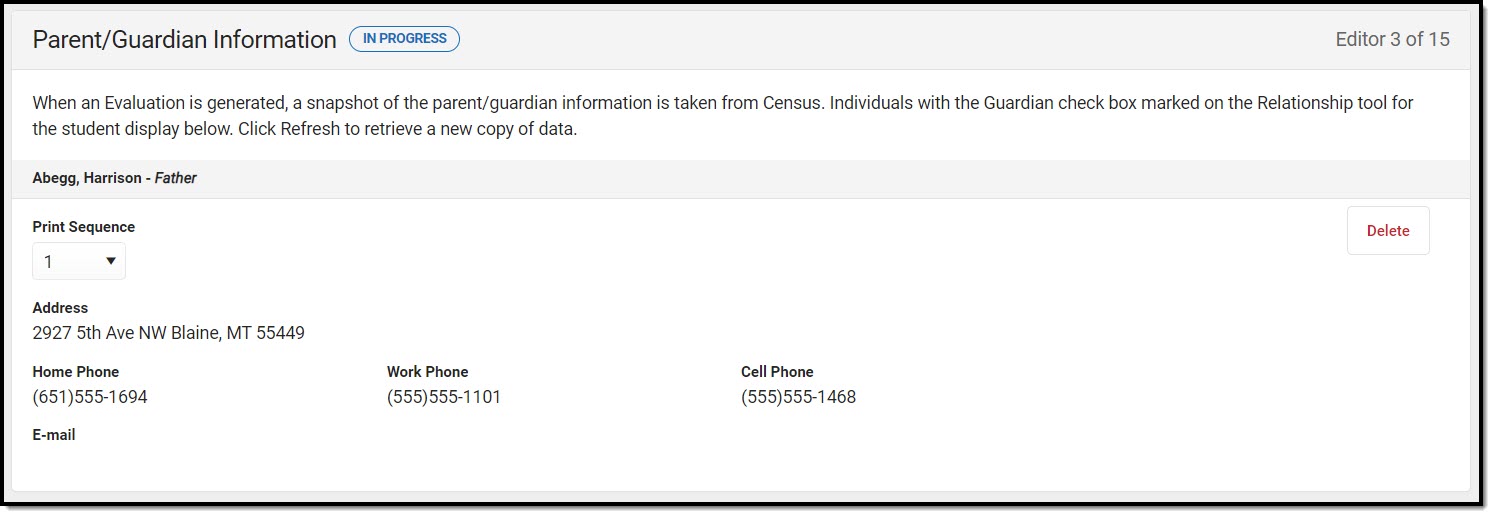 Parent/Guardian Information Editor
Parent/Guardian Information Editor
| Field | Description | Ad Hoc | Validation |
|---|---|---|---|
| Last Name | The last name of the parent/guardian. | Census > People > Demographics > Last Name identity.lastName | This field populates from Census. This is part of the header for the parent/guardian. |
| First Name | The first name of the parent/guardian. | Census > People > Demographics > First Name identity.firstName | This field populates from Census. This is part of the header for the parent/guardian. |
| Middle Name | The suffix of the parent/guardian. | Census > People > Demographics > Suffix Name identity.suffix | This field populates from Census. This is part of the header for the parent/guardian. |
| Suffix | The suffix of the parent/guardian. | Census > People > Demographics > Suffix Name identity.suffix | This field populates from Census. This is part of the header for the parent/guardian. |
| Relationship | The relation of the parent/guardian to the student. | Census > People > Relationships | This field populates from Census. This is part of the header for the parent/guardian. |
| Sequence | The print order of the parent/guardian(s) on the IEP. | N/A | When no Sequence is selected, parent/guardian(s) print in the order displayed in the UI. When any Sequences are selected, only parent/guardian(s) with a sequence number prints in the order defined. |
| Address | The parent/guardians' address. | Census > Households > Address Info address.number; address.street; address.tag; address.prefix; address.dir; address.apt; address.city; address.state; address.zip | This field populates from Census. When there are multiple addresses for a person, a drop down with an option to select which address displays. When there is only one address, the drop down only has one option. The populated address is the one marked "Primary." |
| Work Phone | The work phone of the parent/guardian. | Census > People > Demographics > Work Phone | This field populates from Census. |
| Cell Phone | The cell phone of the parent/guardian. | Census > People > Demographics > Cell Phone | This field populates from Census. |
| The primary email address for the parent/guardian. | Census > People > Demographics > Email | This field populates from Census. |
Enrollment Information
The Enrollment Information editor reports Special Education information from the student's Enrollment.
The Refresh button retrieves a fresh copy of data from the student's record. See the General Information section for additional information.
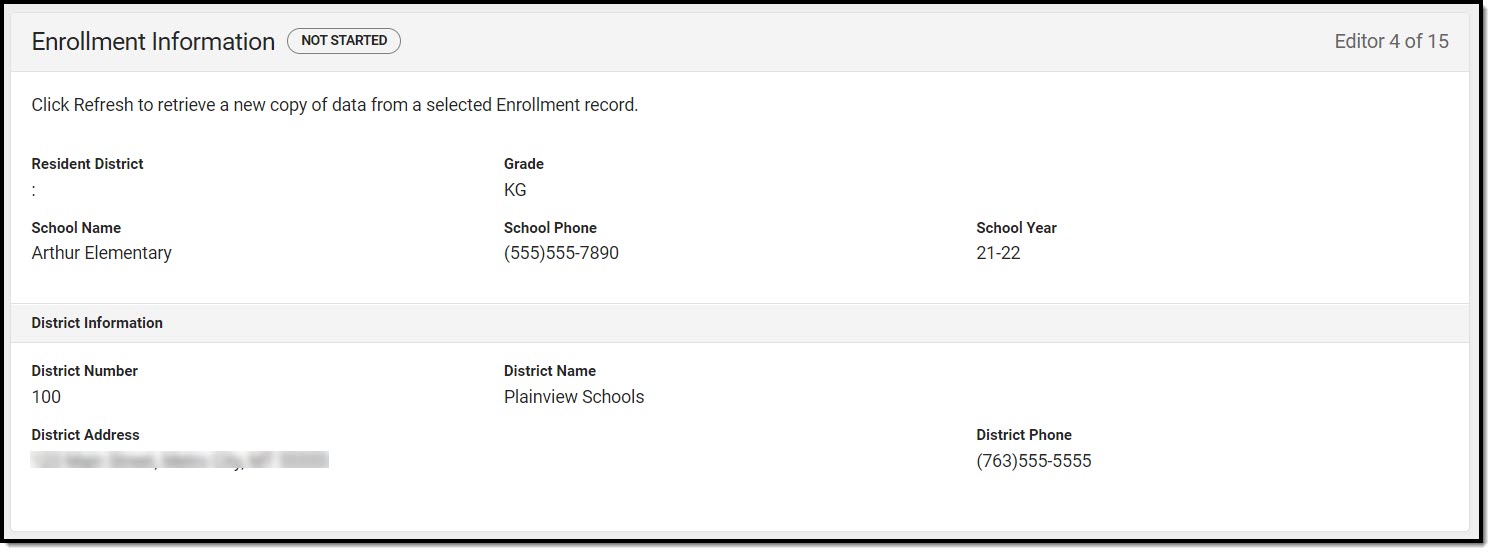 Enrollment Information Editor
Enrollment Information Editor
| Field | Description | Ad Hoc | Validation |
|---|---|---|---|
| Resident District | The district where the student lives. | N/A | This field is pulled from the Enrollment record. This field is read only. |
| School Phone | The phone number of the school associated with the student's Enrollment record. | N/A | This field is pulled from System Administration > Resources > School > School Phone. This field is read only. |
| School Year | The school year. | N/A | This field is pulled from the Enrollment record. This field is read only. |
| Grade | The student's current grade. | Enrollment > Grade enrollment.grade | This field is pulled from the Enrollment record. This field is read only. |
| School Name | The name of the school associated with the student's Enrollment record. | Learner Planning > Learning Plans > servingSchoolName | This field is pulled from the Enrollment record. This field is read only. |
| District Information These fields are read only. | |||
| District Number | The district number associated with the Enrolled school. | N/A | System Administration > Resources > District Information > State District Number |
| District Name | The district name associated with the Enrolled school. | N/A | System Administration > Resources > District Information > Name |
| District Address | The district address associated with the Enrolled school. | N/A | System Administration > Resources > District Information > Address |
| District Phone | The district phone number associated with the Enrolled school. | N/A | System Administration > Resources > District Information > Phone |
Parent/Student Comments
The Parent/Student Comments editor is used to document any evaluation information provided by the parent and/or student.
This editor is required.
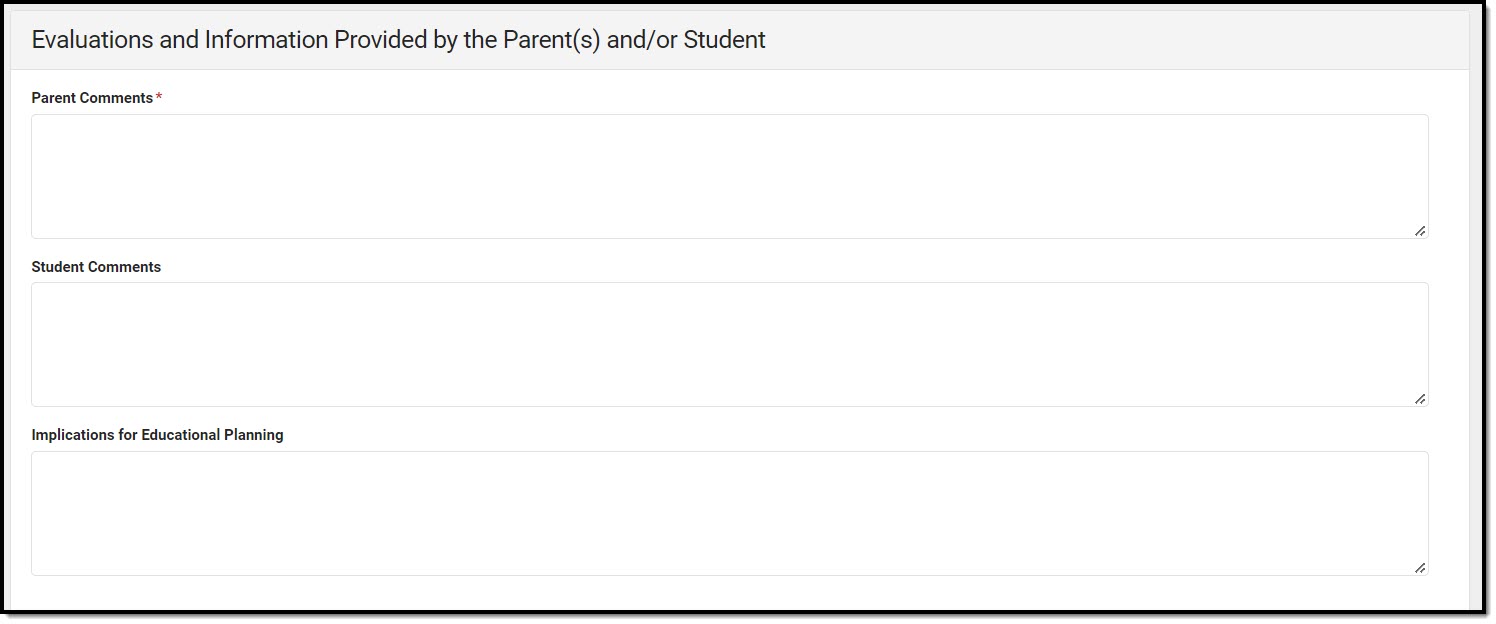 Parent/Student Comments
Parent/Student Comments
| Field | Description |
|---|---|
| Parent Comments Required | A description of the comments provided by the parent/guardian regarding the student evaluation. |
| Student Comments | A description of the comments provided by the student regarding the their evaluation. |
| Implications for Educational Planning | A description of the implications of this information regarding the student's educational planning. |
Classroom Based Assessments
The Classroom Based Assessment editor is used to document any classroom evaluations, results, and implications for instructional planning for the student.
This editor is required.
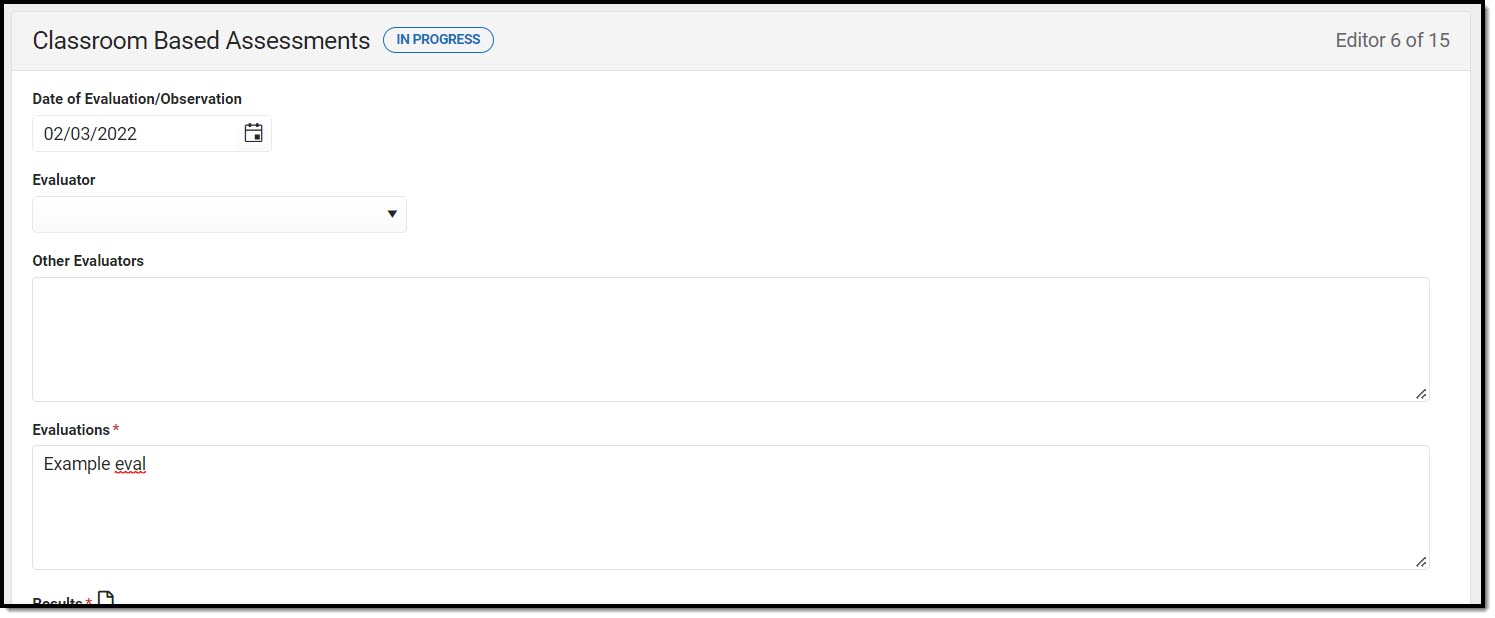 Classroom Based Assessments Editor
Classroom Based Assessments Editor
| Field | Description |
|---|---|
| Date of Evaluation/Observation | The evaluation date. |
| Evaluator | The person completing the evaluation. |
| Other Evaluators | Any other person involved in the evaluation. |
| Evaluations Required | A description of the evaluations done for the student. |
| Results Required | The results of the evaluation. |
| Implications for Instructional Planning Required | A description of the implications of this information regarding the student's instructional planning. |
Observations
The Observations editor is used to document any evaluations, results, and implications for instructional planning for the student.
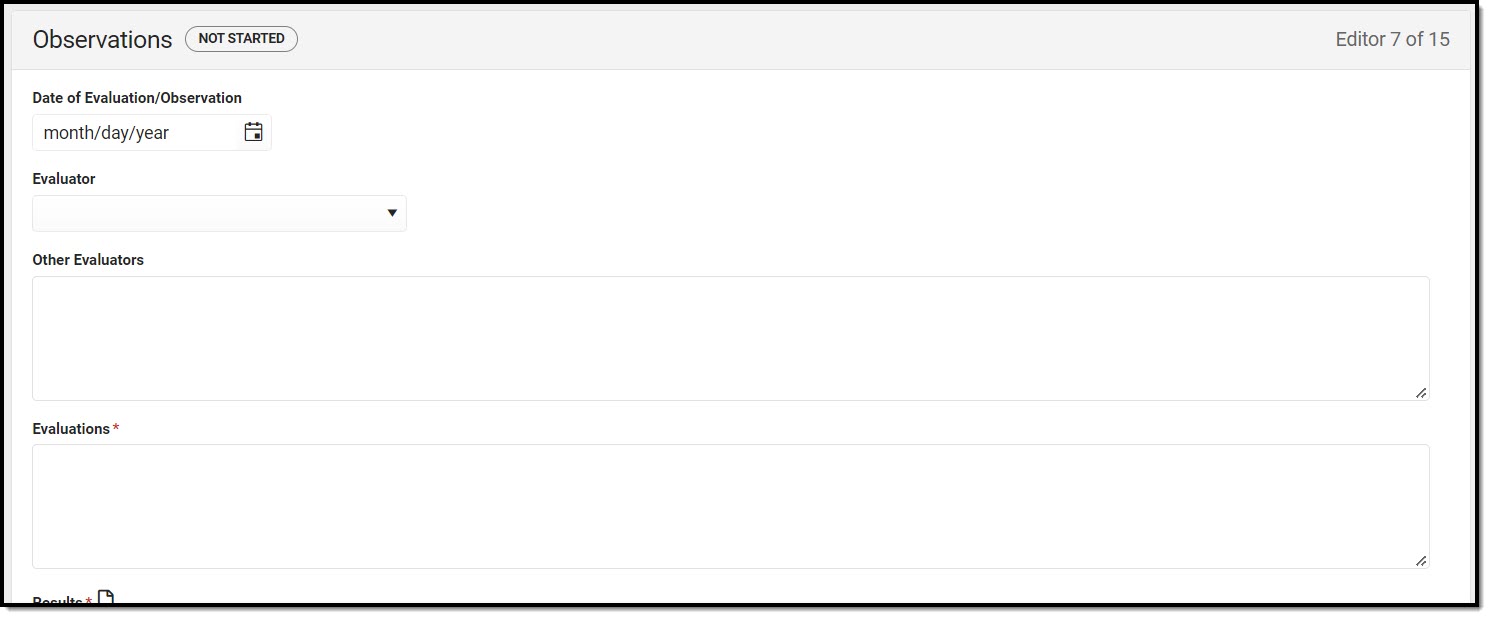 Observations Editor
Observations Editor
| Field | Description | Validation |
|---|---|---|
| Date of Evaluation/Observation | The evaluation date. | N/A |
| Evaluator | The person completing the evaluation. | Users in this dropdown are based on staff members who have the Special Ed checkbox marked on their District Assignment. |
| Other Evaluators | Any other person involved in the evaluation. | N/A |
| Evaluations Required | A description of the evaluations done for the student. | N/A |
| Results Required | The results of the evaluation. | N/A |
| Implications for Instructional Planning Required | A description of the implications of this information regarding the student's instructional planning. | N/A |
Assessments
The Assessments editor is used to document the type of assessments used to evaluate the student.
Assessments List Screen
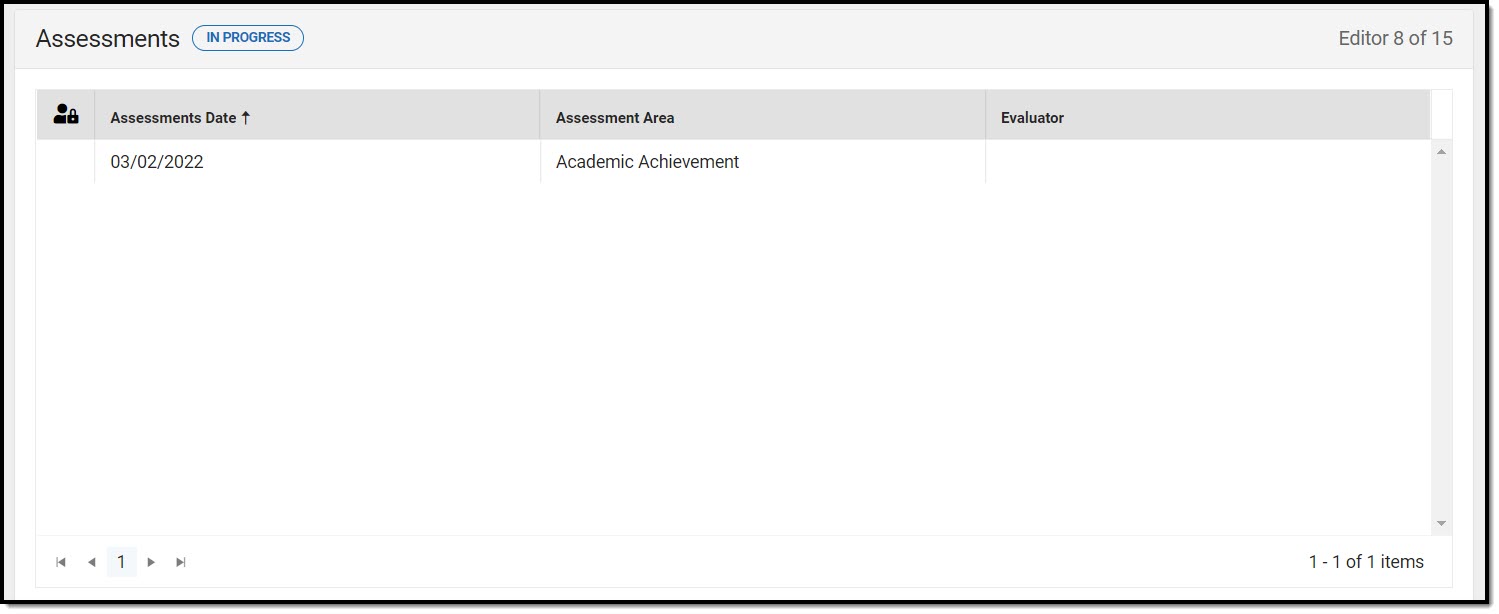 Assessments List Screen
Assessments List Screen
| Field | Description |
|---|---|
| Padlock Icon | The user currently editing the record. |
| Assessments Date | The date of the assessment. |
| Assessment Area | The area of assessment. |
| Evaluator | The person completing the evaluation. |
Assessments Detail Screen
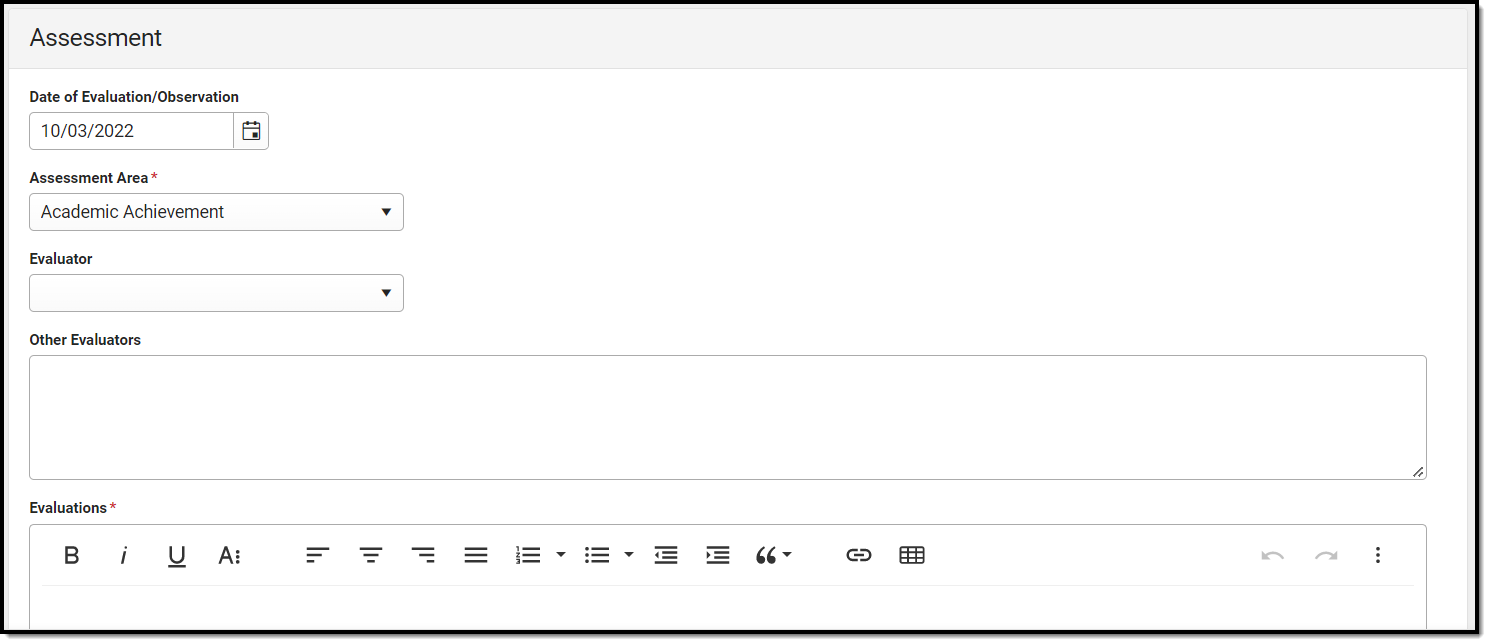 Assessments Detail Screen
Assessments Detail Screen
| Field | Description |
|---|---|
| Date of Evaluation/Observation | The evaluation date. |
| Assessment Area Required | The area of assessment. Options include:
|
| Evaluator | The person completing the evaluation. |
| Other Evaluators | Any other person involved in the evaluation. |
| Evaluations Required | A description of the evaluations done for the student. |
| Results Required | The results of the evaluation. |
| Implications for Instructional Planning Required | A description of the implications of this information regarding the student's instructional planning. |
Determination of Eligibility Checklist
The Determination of Eligibility editor provides a collection of checklists for each disability the student is determined to have. Checklists include the considerations and questions to be addressed for that disability.
Determination of Eligibility Checklist List Screen
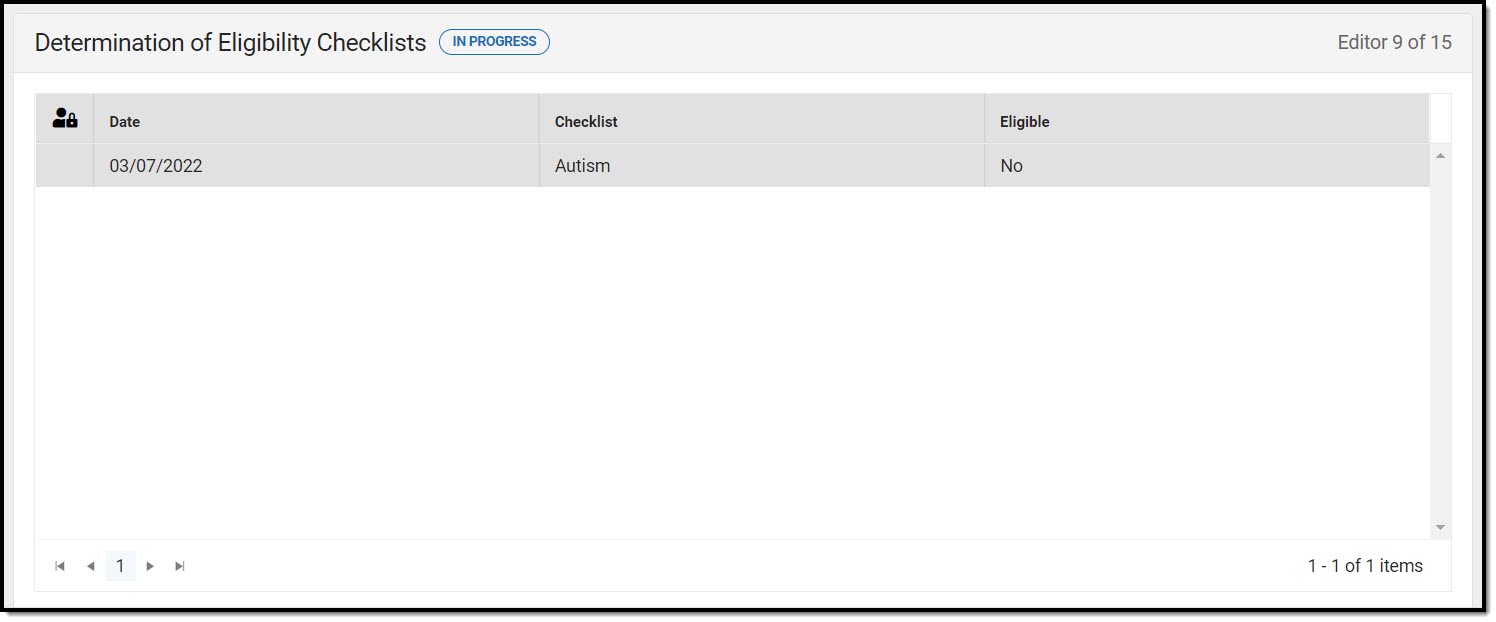 Determination of Eligibility Checklist List Screen
Determination of Eligibility Checklist List Screen
| Field | Description |
|---|---|
| Padlock Icon | The user currently editing the record. |
| Date | The date the determination was made. |
| Checklist | The checklist item. |
| Eligible | Indicates the eligibility status of each checklist item. |
Determination of Eligibility Checklist Detail Screen
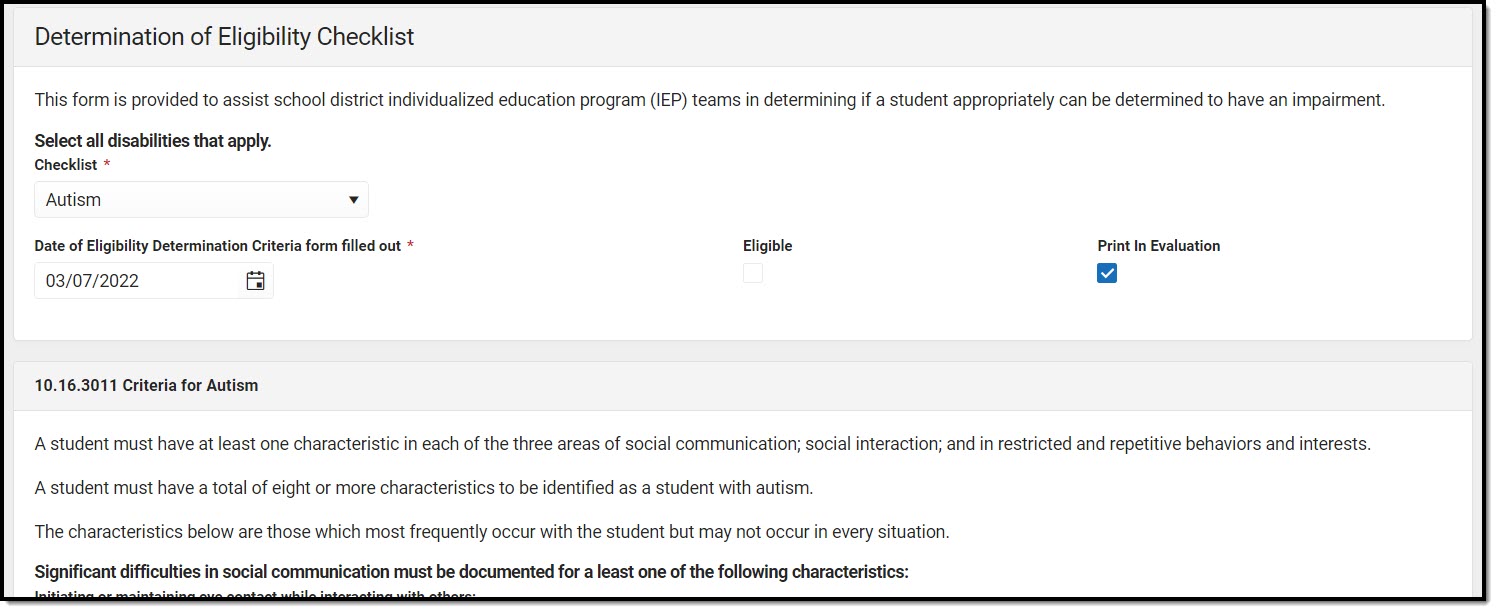 Determination of Eligibility Checklist Detail Screen - Autism Example
Determination of Eligibility Checklist Detail Screen - Autism Example
| Field | Description | Validation |
|---|---|---|
| Checklist Required | The checklist item. Options include:
| When an option is selected from the drop down, the criteria checklist displays (see below). |
| Date of Eligibility Determination Criteria form filled out Required | The date the determination criteria form was completed. | N/A |
| Eligible | Indicates the eligibility status of each checklist item. | N/A |
| Print in Evaluation | Indicates this record prints. | This is marked by default. |
Autism Criteria Checklist
| Field | Validation |
|---|---|
| Initiating or maintaining eye contact while interacting with others: | Yes or No |
| Use of facial expressions to communicate with others: | Yes or No |
| Identifying and/or understanding the communicative intent of another person's facial expressions; | Yes or No |
| Using gestures to direct attention to an object (for example: showing, bringing or pointing out objects of interest; | Yes or No |
| Using gestures for communication; | Yes or No |
| Responding to or interpreting other's use of gestures; | Yes or No |
| Noticing or interpreting other's use of body language; | Yes or No |
| Use of own body language for communication; | Yes or No |
| Expressive verbal or alternative communication; | Yes or No |
| Receptive verbal or alternative communication; or | Yes or No |
| Interpretation of other's verbal communication (often concrete and literal; for example: does not understand idioms or sarcasm) | Yes or No |
| Significant difficulties in social interaction must be documented for at least one of the following characteristics: | |
| Seeking to share enjoyment, interests, or achievements with others; | Yes or No |
| Initiating social interaction unless seeking preferred items or help; | Yes or No |
| Responding to social interactions initiated by others; | Yes or No |
| Initiating a conversation on non-preferred topics | Yes or No |
| Sustaining a conversation on non-preferred topics; | Yes or No |
| Explaining another person's perspective (for example: what other people are thinking or feeling); | Yes or No |
| Joining play activities of others (solitary play preferred); | Yes or No |
| Play lacks elements of make-believe; | Yes or No |
| Participating in make-believe play with others; or | Yes or No |
| Engaging in social imitative play (for example: playacting, fantasy characters, animals, pretending, adult role). | Yes or No |
| Significant difficulties resulting from restricted and repetitive behaviors and interests must be documented for at least one of the following characteristics: | |
| Makes repeated vocalizations or verbalizations (for example: repeats same word, phrase or sound); | Yes or No |
| Persistent preoccupation with specific objects or parts of objects; | Yes or No |
| Engages in repeated, repetitive movements with objects such as sticks or string, lining up toys, flipping objects, spinning objects; | Yes or No |
| Preoccupation with particular interests causes difficulties in social interaction and/or academic performance; | Yes or No |
| Resists when asked to discontinue preferred or special interest activity; | Yes or No |
| Prefers consistency and resists expected and/or unexpected changes (for example: changing activities, leaving activity unfinished, changes in routine or daily schedule); or | Yes or No |
| Engages in repetitive physical behaviors such as body rocking, spinning self, finger flicking, hand flapping. | Yes or No |
| Does the student have at least on characteristic in each of these three areas: | |
| Social Communication | Yes or No |
| Social Interaction | Yes or No |
| Restricted and Repetitive Behaviors and Interests | Yes or No |
Total number of characteristics in all three areas: | Must have eight or more. |
| Student Name | This information pulls from the Census record. |
| Evaluation Meeting Date | N/A |
| Additional Required Team Members Required team members for the determination of Autism must be a school psychologist and a speech-language pathologist, each of whom is qualified to conduct individual diagnostic examinations of children. | |
| Psychologist Name Required | N/A |
| Speech-Language Pathologist Name Required | N/A |
Cognitive Delay
| Field | Validation |
|---|---|
| The student has a significantly sub average general intellectual functioning; and | Yes or No |
| Corresponding deficits in adaptive behavior and educational performance, especially in the area of application of basic academic skills in daily life activities. | Yes or No |
| The presence of sub average general intellectual functioning must occur between conception and the 18th birthday. | Yes or No |
| Definitions: | |
| Student Name | Pulls from Census |
| Evaluation Meeting Date | N/A |
| Additional Required Team Members Required team members for the determination of cognitive delay must be a school psychologist, whom is qualified to conduct individual diagnostic examinations of children | |
| Psychologist Name Required | N/A |
Deafness
| Field | Validation |
|---|---|
| An audiological report documents that hearing loss is so severe that the student is impaired in processing linguistic information, with or without amplification, to the extend that prevents the auditory channel from being the primary mode of speech and language. | Yes or No |
| The student's education performance is adversely affected as documented by specific examples: | Yes or No |
| Specify: | N/A |
| Definitions: | |
| Student Name | This information pulls from the Census record. |
| Evaluation Meeting Date | N/A |
| Additional Required Team Members Required team members for the determination of deafness must be a speech-language pathologist or an audiologist, each of whom is qualified to conduct individual diagnostic examinations of children. | |
| Speech-Language Pathologist Name | N/A |
| Audiologist Name | N/A |
Deaf-Blindness
| Field | Validation |
|---|---|
| The student: | N/A |
| Meets the criteria in ARM 10.16.3022 for visual impairment; | Yes or No |
| Meets the criteria in ARM 10.16.3020 for speech-language impairment; | Yes or No |
| Meets the criteria in ARM 10.16.3016 for hearing impairment or in ARM 10.16.3014 for deafness; and | Yes or No |
| Is experiencing severe delays in communication and other developmental and educational skills such as the services designed solely for students with deafness or for students with blindness would not meet the student's educational needs. | Yes or No |
| Student Name | This information pulls from the Census record. |
| Evaluation Meeting Date | N/A |
| Additional Required Team Members Required team members for the determination of deaf-blindness must be a speech-language pathologist, whom is qualified to conduct individual diagnostic examinations of children. | |
| Speech-Language Pathologist Name Required | N/A |
Developmental Delay
| Field | Validation |
|---|---|
| The student is at least three (3) and not yet nine (9) years old. | N/A |
| The student functions at a developmental level: | N/A |
| Two or more standard deviations below the norm in any ONE of the following areas of development: | N/A |
| Areas of Development | Options include:
|
| or | N/A |
| 1.5 more more standard deviations below the norm in TWO OR MORE of the following areas of development: | N/A |
| Areas of Development | Options include:
|
| Documentation of a developmental delay must include: | N/A |
| Appropriate developmental assessment that addressed each of the areas above. | N/A |
| Observation of the student's communication development and social and emotional development in a classroom or other group setting | N/A |
| Student Name | This information pulls from the Census record. |
| Evaluation Meeting Date | N/A |
Emotional Disturbance
| Field | Validation |
|---|---|
| An inability to build or maintain satisfactory relationships with peers and teachers; | Yes or No |
| Inappropriate types of behavior or feelings under normal circumstances, including behaviors which are psychotic or bizarre in nature or behaviors which are atypical and for which no observable reason exists; | Yes or No |
| A general, pervasive mood of unhappiness or depression, including major depression and dysthymia, but excluding normal grief reactions; | Yes or No |
| A tendency to develop physical symptoms or fears associated with personal or school problems, including separation anxiety, avoidant disorder and overanxious disorder; | Yes or No |
| Schizophrenia | Yes or No |
| Each of the conditions above shall meet the criteria having been present: | |
| To a marked degree, | Yes or No |
| Over a long period of time, and | Yes or No |
| Adversely affecting the student's educational performance. | Yes or No |
| The student has been observed in more than one setting within the educational environment | Yes or No |
| The local education agency has planned and implemented one or more positive behavioral interventions specific to the individual student. | Yes or No |
| Interventions shall not unnecessarily delay appropriate identification when it can be shown through a student's social or developmental history, compiled directly from the student's parents or from records when the parents are not available, the existence of characteristics that clearly identify emotional disturbance. | N/A |
| Exclusionary Factors The student may not be identified as having emotional disturbance if: Delays in educational performance are primarily due to visual impairment, hearing impairment, orthopedic impairment, cognitive delay, health factors, cultural factors or limited educational opportunity. Common disciplinary problems may exist in conjunction with emotional disturbance, but cannot be used as the sole criteria for determining the existence of an emotional disturbance. The term emotional disturbance does not apply to students who are socially maladjusted, unless it is determined that they meet the criteria for emotional disturbance. | |
| Definitions: "Adversely affect the student's educational performance" means that there is evidence that measures of student performance (e.g. achievement tests, grades, behavioral assessments, analysis of classroom assignments, or criterion-referenced tests, etc.) indicate a pattern of educational attainment that can wholly or in part be attributed to the disabling condition. | |
| Student Name | This information pulls from the Census record. |
| Evaluation Meeting Date | N/A |
| Additional Required Team Members Required team members for the determination of emotional disturbance must be a school psychologist, whom is qualified to conduct individual diagnostic examinations of children. | |
| Psychologist Name Required | N/A |
Hearing Impairment
| Field | Validation |
|---|---|
| An audiological report documents a permanent hearing loss in excess of 20dB better ear average in the speech range (500, 1,000 or 2,000 Hz), unaided, or | Yes or No |
| A history of fluctuation hearing loss which has interrupted the normal acquisition of speech and language and continues to adversely affect educational performance. | Yes or No |
| Definitions: "Adversely affect the student's educational performance" means that there is evidence that measures of student performance (e.g. achievement tests, grades, behavioral assessments, analysis of classroom assignments, or criterion-referenced tests, etc.) indicate a pattern of educational attainment that can wholly or in part be attributed to the disabling condition. | |
| Student Name | This information pulls from the Census record. |
| Evaluation Meeting Date | N/A |
| Additional Required Team Members Required team members for the determination of hearing impairment must be a speech-language pathologist or an audiologist, each of whom is qualified to conduct individual diagnostic examinations of children. | |
| Speech-Language Pathologist Name | N/A |
| Audiologist Name | N/A |
Learning Disability RTI
| Field | Validation |
|---|---|
| The student has been provided learning experiences appropriate to the student's age or grade-level based on state-approved K-12 content standards. | Yes or No |
| The student did not make sufficient progress to meet age or grade level based on state-approvedK-12 content standards in one or more of the following areas | Yes or No |
| Areas: | Options include:
|
| The student was determined to have a specific learning disability based on an insufficient response to scientific, research-based interventions resulting in a low level of academic achievement. | Yes or No |
| Insufficient response to interventions occurred when, despite the implementation of the interventions over a sustained period of time, the student did not achieve adequately based on the student's age or grade level based on state-approved K-12 content standards. | Yes or No |
| Scientific, research based interventions were: | |
| Matched to the specific needs of the student as identified through systematic, data-based processes for examining the presenting problem, including parental input, to identify instructional interventions that have a high likelihood of success; | Yes or No |
| Focused on changing the instructional strategies or techniques used with the student; and | Yes or No |
| Regularly monitored for student progress and correct implementation via regular and frequent data collection, and analyzed and modified as necessary based on data analysis. | Yes or No |
| In determining the response to scientific research-based interventions the evaluation team considered data: | |
| Regarding how appropriately the intervention was delivered by qualified personnel, and | Yes or No |
| Comparing the student's rate of learning and current levels of performance with the student's initial levels of performance | Yes or No |
| The student did not make sufficient response to scientific, research-based interventions, and | Yes or No |
| The level of intervention necessary to sustain the response can only be provided through special education services. | Yes or No |
| Documentation also includes: | |
| The scientific, research-based interventions and instructional strategies uses; and | Yes or No |
| The student-centered data collected during the implementation of at least two intensive individualized interventions implemented for a sustained period of time. | Yes or No |
| The evaluation team documented the student's academic performance in the regular classroom setting through observation. | Yes or No |
| Requirements for documentation of observation were met by observation of routine classroom instruction and monitoring of the student's performance that was done before the child was referred or an evaluation, or | Yes or No |
| At least one member of the evaluation team conducted an observation of the child's academic performance in the regular classroom after the child has been referred for an evaluation and parental consent was obtained. | Yes or No |
| If the student was younger than school age or out of school, an evaluation team member observed the student in an environment for a student of that age. | Yes or No |
| Educationally relevant medical findings, if any, were considered; and | Yes or No |
| Two or more interventions specific to the individual student were implemented. | Yes or No |
| Interventions did not unnecessarily delay appropriate identification. | Yes or No |
| Exclusionary Factors: The student may not be identified as having a specific learning disability if the student's significantly low rate of progress in meeting age or grade level based on state-approved K-12 content standards is primarily the result of a visual, hearing, or motor impairment; cognitive delay; emotional disturbance; environmental or economic disadvantage; cultural factors; or a lack of appropriate instruction. | |
| Student Name: | This information pulls from the Census record. |
| Evaluation Meeting Date: | N/A |
| Additional Required Team Members: Required team members for the determination of specific learning disability must be a school psychologist, a speech-language pathologist, or a remedial reading teacher, each of whom is qualified to conduct individual diagnostic examinations of children. | |
| Psychologist Name | N/A |
| or; | N/A |
| Speech-Language Pathologist Name | N/A |
| or; | N/A |
| Remedial Reading Teacher Name | N/A |
Learning Disability - Severe Discrepancy
| Field | Validation |
|---|---|
| The student has been provided learning experiences appropriate to the student's age or grade-level based on state-approved K-12 content standards | Yes or No |
| The student did not make sufficient progress to meet age or grade level based on state-approved K-12 content standards in one or more of the following areas: | Yes or No |
| Areas: | Options include:
|
| The student was determined to have a specific learning disability based on a severe discrepancy between the student's intellectual ability and achievement in one or more of the areas listed in ARM 10.16.3019. | Yes or No |
| Documentation also includes: | |
| The evaluation team documented the student's academic performance in the regular classroom setting through observation. | Yes or No |
| Requirements for documentation of observation were met by observation of routine classroom instruction and monitoring of the student's performance that was done before the child was referred for an evaluation, or | N/A |
| At least one member of the evaluation team conducted an observation of the child's academic performance in the regular classroom after the child has been referred for an evaluation and parental consent was obtained. | Yes or No |
| If the student was younger than school age or out of school, an evaluation team member observed the student in an environment appropriate for a student of that age. | Yes or No |
| Educationally relevant medical findings, if any, were considered; and | Yes or No |
| Two or more interventions specific to the individual student were implemented. | Yes or No |
| Interventions did not unnecessarily delay appropriate identification. | Yes or No |
| Exclusionary Factors: The student may not be identified as having a specific learning disability if the student's significantly low rate of progress in meeting age or grade level based on state approved K-12 content standards is primarily the result of a visual, hearing, or motor impairment; cognitive delay; emotional disturbance; environmental or economic disadvantage; cultural factors; or a lack of appropriate instruction. | |
| Definitions: (a) A severe discrepancy is defined as a 50 percent or higher probability of a two standard deviation discrepancy between general cognitive ability and achievement in one or more of the areas identified in ARM 10.16.3019 when adjusted for regression to the population mean. (b) Error in test measurement requires judgment for students who score near two standard deviations below the population mean. When exercising this judgment, consideration of additional information, such as classroom performance relative to the student's performance on norm-referenced tests, shall be used as the basis for determining the severe discrepancy. (c) Alternatives to norm-referenced tests, such as curriculum-based assessments, shall be utilized to determine severe discrepancy whenever cultural factors, test conditions, size of test item sampling for the student's age, or other factors render standardized assessment results invalid. When utilizing alternative assessment procedures, a determination must still be made that a discrepancy between ability and achievement exists at a level of severity similar in size to the discrepancy that would have otherwise been found as described in (a) above. | |
| Student Name: | This information pulls from the Census record. |
| Evaluation Meeting Date: | N/A |
| Additional Required Team Members: Required team members for the determination of specific learning disability must be a school psychologist, a speech-language pathologist, or a remedial reading teacher, each of whom is qualified to conduct individual diagnostic examinations of children. | |
| Psychologist Name | N/A |
| or; | N/A |
| Speech-Language Pathologist Name | N/A |
| or; | N/A |
| Remedial Reading Teacher Name | N/A |
Orthopedic Impairment
| Field | Validation |
|---|---|
| The student is diagnosed by a qualified medical practitioner as having an orthopedic impairment | Yes or No |
| The impairment is severe; and | Yes or No |
| The impairment adversely affects the student's educational performance | Yes or No |
| Definitions: The term orthopedic impairment includes impairments caused by congenital anomaly (e.g., clubfoot, absence of some member, etc.), impairments caused by disease (e.g., poliomyelitis, bone tuberculosis, etc.), and impairments from other causes (e.g., cerebral palsy, amputations, and fractures or burns that cause contractures). "Adversely affect the student's educational performance" means that there is evidence that measures of student performance (e.g., achievement tests, grades, behavioral assessments, analysis of classroom assignments, or criterion-referenced tests, etc.) indicate a pattern of educational attainment that can wholly or in part be attributed to the disabling condition. | |
| Student Name: | This information pulls from the Census record. |
| Evaluation Meeting Date: | N/A |
Other Health Impairment
| Field | Validation |
|---|---|
| The student has limited strength, vitality or alertness, including a heightened alertness to environmental stimuli that results in limited alertness with respect to the educational environment, that is due to chronic or acute health problems such as asthma, attention deficit disorder or attention deficit hyperactivity disorder, diabetes, epilepsy, a heart condition, hemophilia, lead poisoning, leukemia, nephritis, rheumatic fever, sickle cell anemia or tuberculosis; and | Yes or No |
| The condition adversely affects the student's educational performance. | Yes or No |
| The student has medical diagnosis of a chronic or acute health problem. (REQUIRED) | Yes or No |
| Definitions: "Adversely affect the student's educational performance" means that there is evidence that measures of student performance (e.g., achievement texts, grades, behavioral assessments, analysis of classroom assignments, or criterion-referenced tests. etc.) indicate a pattern of educational attainment that can wholly or in part be attributed to the disabling condition. | |
| Student Name: | This information pulls from the Census record. |
| Evaluation Meeting Date: | N/A |
Speech-Language Impairment
| Field | Validation |
|---|---|
| The student has a significant deviation in speech such as fluency, articulation or voice; or | Yes or No |
| The student has a significant deviation in the ability to decode or encode oral language which involves phonology, morphology, semantics or pragmatics or a combination thereof. | Yes or No |
| Documentation of the student's interpersonal communication effectiveness in a variety of educational settings by the teacher, parents, speech-language pathologist, and others as appropriate supports the adverse educational effect of the speech-language impairment or oral communication in a classroom or school setting | Yes or No |
| Exclusionary Factors: The student may not be identified as having a speech-language impairment if the speech or language problems primarily result from environmental or cultural factors. | |
| Definitions: The student has a significant deviation in oral performance if the student’s performance on standardized test is two standard deviations below the population mean, or between 1.5 and two standard deviations below the population mean, and there is documented evidence over a six month period prior to the current evaluation of no improvement in the speech-language performance of the student even with regular classroom interventions. For articulation, a significant deviation is consistent articulation errors persisting one year beyond the highest age when 90 percent of the students have acquired the sounds based upon specific developmental norms. If norm-referenced procedures are not used, alternative assessment procedures shall substantiate a significant deviation from the norm. | |
| Student Name: | This information pulls from the Census record. |
| Evaluation Meeting Date: | N/A |
| Speech-Language Pathologist Name: | N/A |
Traumatic Brain Injury
| Field | Validation |
|---|---|
| The student has an acquired injury to the brain caused by external physical force which substantially limits the student's functional or psychosocial ability or both and the student's ability to learn or participate in the general education curriculum. | Yes or No |
| Exclusionary Factors: The student may not be identified as having a traumatic brain injury if the injury to the brain is congenital, degenerative, or caused by birth trauma. | |
| Definitions: The term traumatic brain injury applied to open or closed head injuries resulting in impairments in one or more areas such as cognition, language, memory, attention, reasoning, abstract thinking, judgement, problem solving, sensory, perceptual, and motor abilities, psycho-social behavior, physical function, information processing, and speech. | |
| Student Name: | This information pulls from the Census record. |
| Evaluation Meeting Date: | N/A |
| Additional Required Team Members: Required team members for the determination of traumatic brain injury must be a school psychologist and a speech-language pathologist, each of whom is qualified to conduct individual diagnostic examinations of children. | |
| Psychologist Name | N/A |
| Speech-Language Pathologist Name: | N/A |
Visual Impairment
| Field | Validation |
|---|---|
| The student has an impairment in vision that, even with correction, adversely affects the student's educational performance; | Yes or No |
| or | N/A |
| The student has a medically indicated expectation of visual deterioration that would qualify the child as having a visual impairment as described above. | Yes or No |
| Student Name: | This information pulls from the Census record. |
| Evaluation Meeting Date: | N/A |
Eligibility Determination
The Eligibility Determination editor lists the student's determining factor for qualifying for Special Education services.
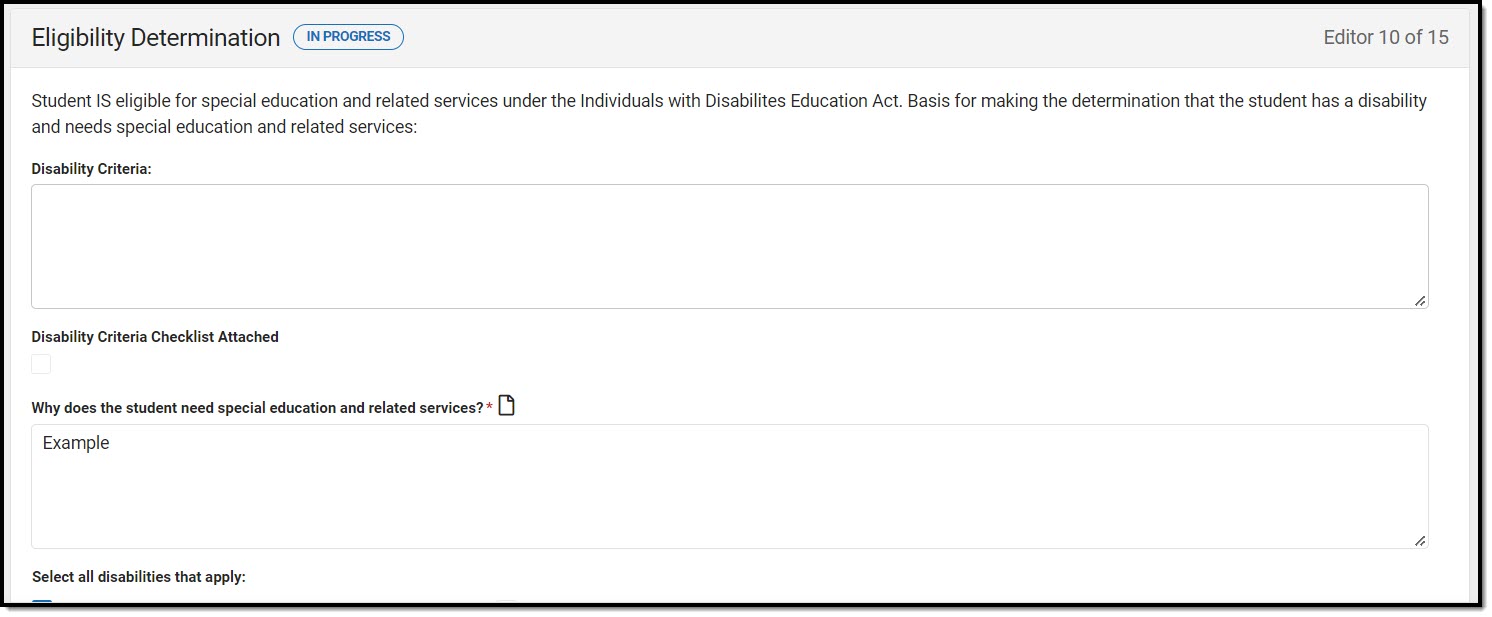 Eligibility Determination Editor
Eligibility Determination Editor
| Field | Description | Validation |
|---|---|---|
| Eligibility Determination | ||
| Student IS eligible for special education and related services under the Individuals with Disabilities Education Act. Basis for making the determination that the student has a disability and needs special education and related services: | Indicates the student is eligible to receive services. | N/A |
| Disability Criteria: | A description of the disability criteria. | N/A |
| Disability Criteria Checklist Attached | Indicates disability criteria checklist has been attached to the evaluation. | N/A |
| Why does the student need special education and related services? Required | An explanation for why the student needs services. | N/A |
| Select all disabilities that apply: | The student's disabilities. Options include:
| Multiple options can be selected. |
| Specify Specific Learning Disability *Required | The specific learning disability. Options include: RTI and Severe Discrepancy. | *This field is available and required when Specific Learning Disability is selected above. |
| If this is an initial evaluation, was the student referred from Part C? | Indicates if the student was referred from Part C. | Yes or No |
| Date Referred | The date the student was referred. | N/A |
| Reason the IEP was not developed and implemented by the child's third birthday: | The reason the IEP was not created for the student by their third birthday.
| N/A |
Recommendations
The Recommendations editor is used to document the recommended areas of service the student may need for the IEP team.
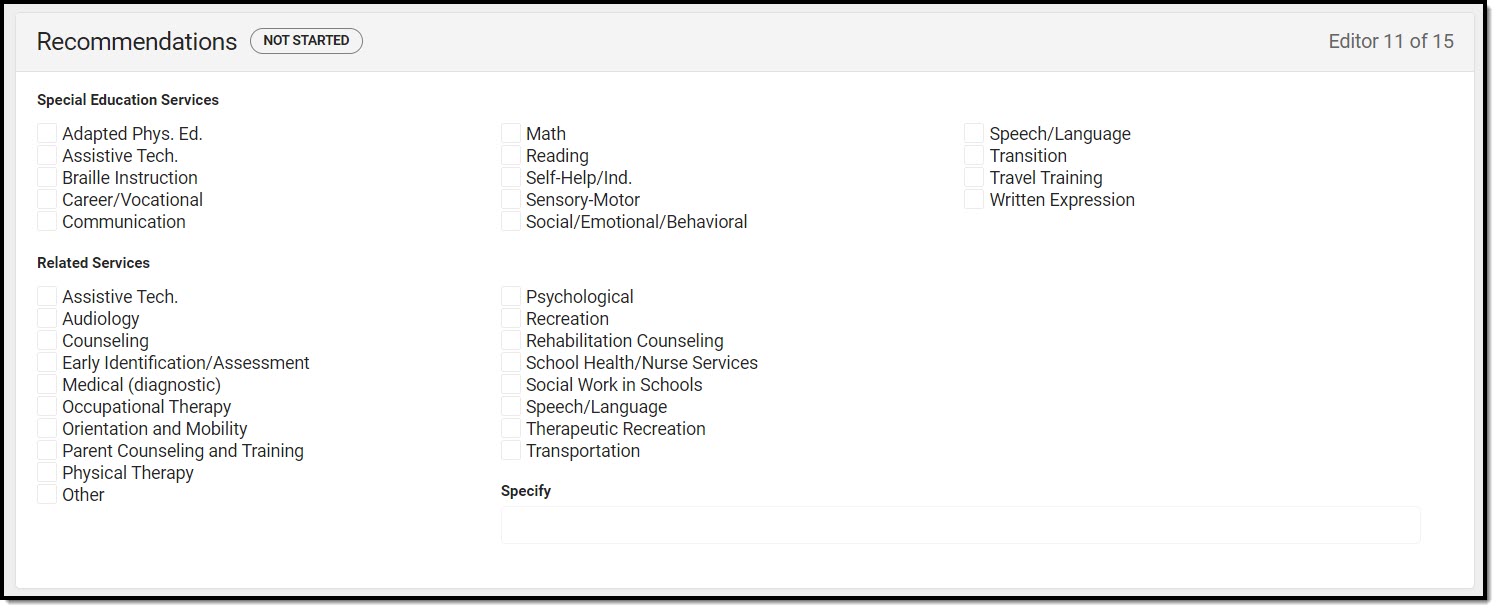 Recommendations Editor
Recommendations Editor
| Field | Description | Validation |
|---|---|---|
| Special Education Services | A list of the recommended services. Options include:
| Multiple options can be selected. |
| Related Services | A list of the recommended related services. Options include:
| Multiple options can be selected. |
| If other, specify | A description of the other service, if applicable. | This field displays and is required when "Other" is selected above. |
Dissenting Report
The Dissenting Report editor is used to document any opinions regarding the student's evaluation and recommended services that do not match those of the rest of the evaluation team.
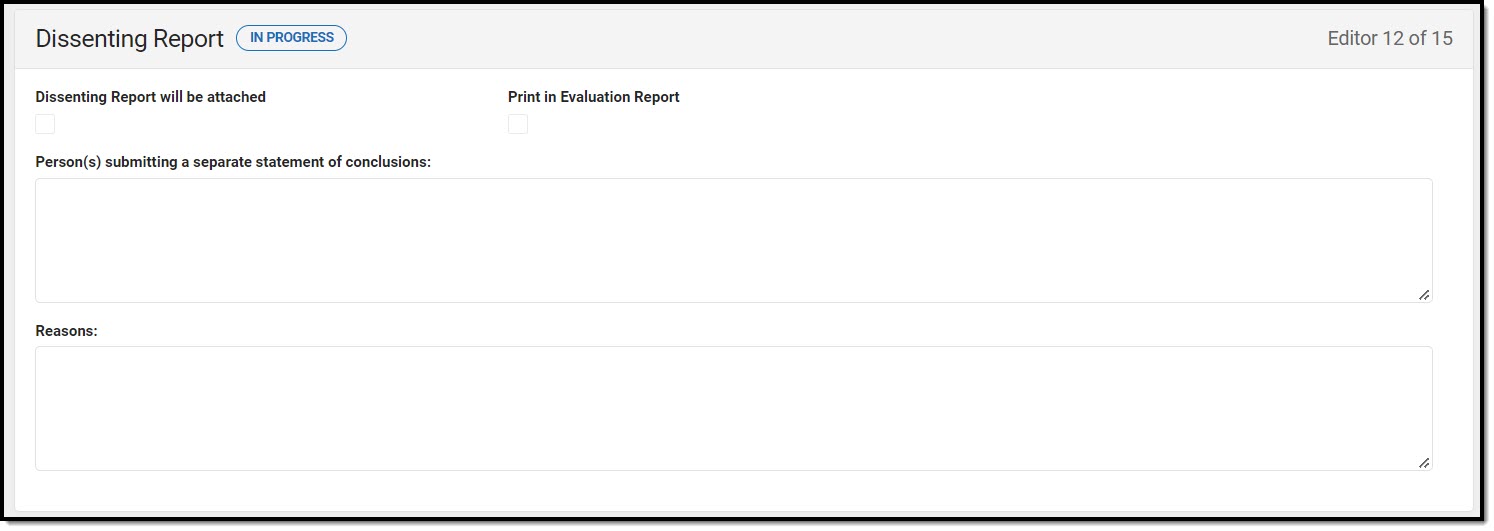 Dissenting Report Editor
Dissenting Report Editor
| Field | Description |
|---|---|
| Dissenting Report will be attached | Indicates a dissenting report is attached to the evaluation. |
| Print in Evaluation Report | Indicates this editor prints on the evaluation report. |
| Person(s) submitting a separate statement of conclusions: | The people submitting the separate documentation. |
| Reasons: | The reasons for dissent. |
Not Eligible
The Not Eligible editor is used to document if the student is not eligible to receive special education services.
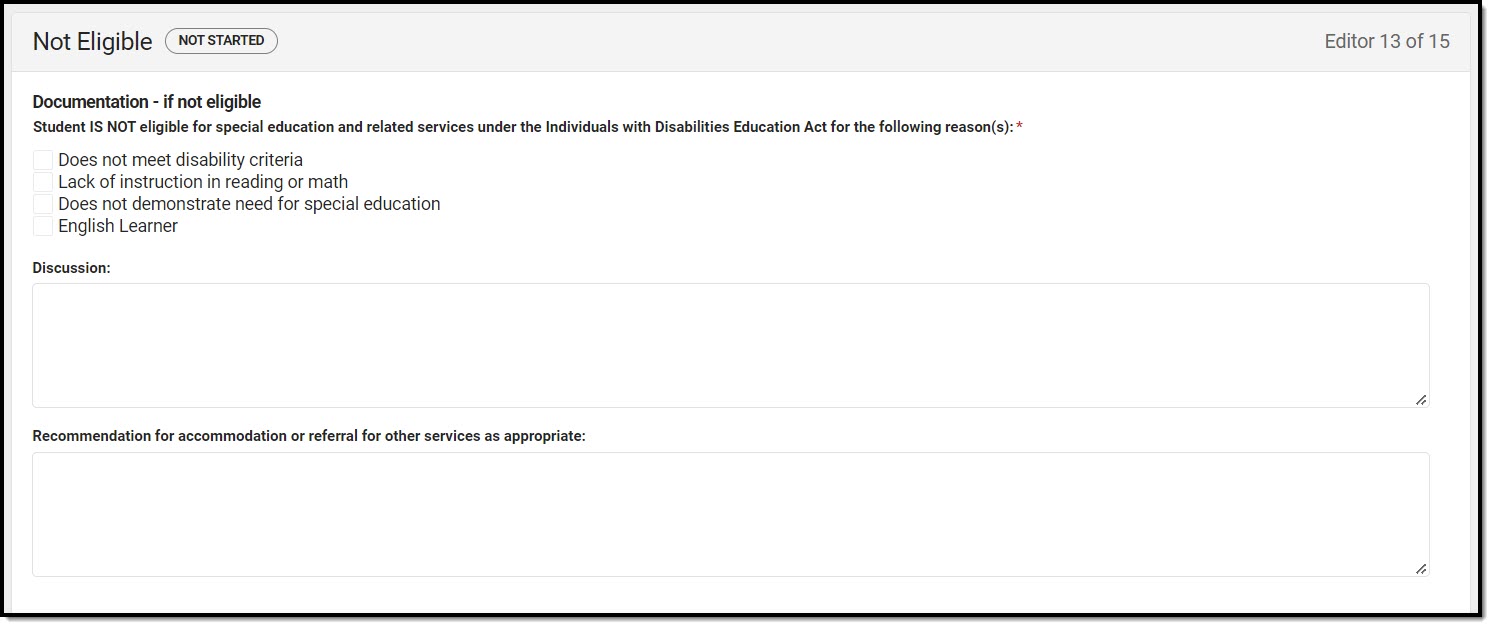 Not Eligible Editor
Not Eligible Editor
| Field | Field |
|---|---|
| Student IS NOT eligible for special education and related services under the Individuals with Disabilities Education Act for the following reason(s): Required | The reason the student is ineligible to receive services. Options include:
|
| Discussion | A description of the eligibility status. |
| Recommendation for accommodation or referral for other services as appropriate: | A description of accommodations or referral for other services, if applicable. |
Prior Written Notice
The prior written notice editor is used to document the action proposed/refused of the initiation or change in the evaluation or identification of the student and detailed explanations and descriptions of additional considerations, factors, and reasoning.
This editor is required.
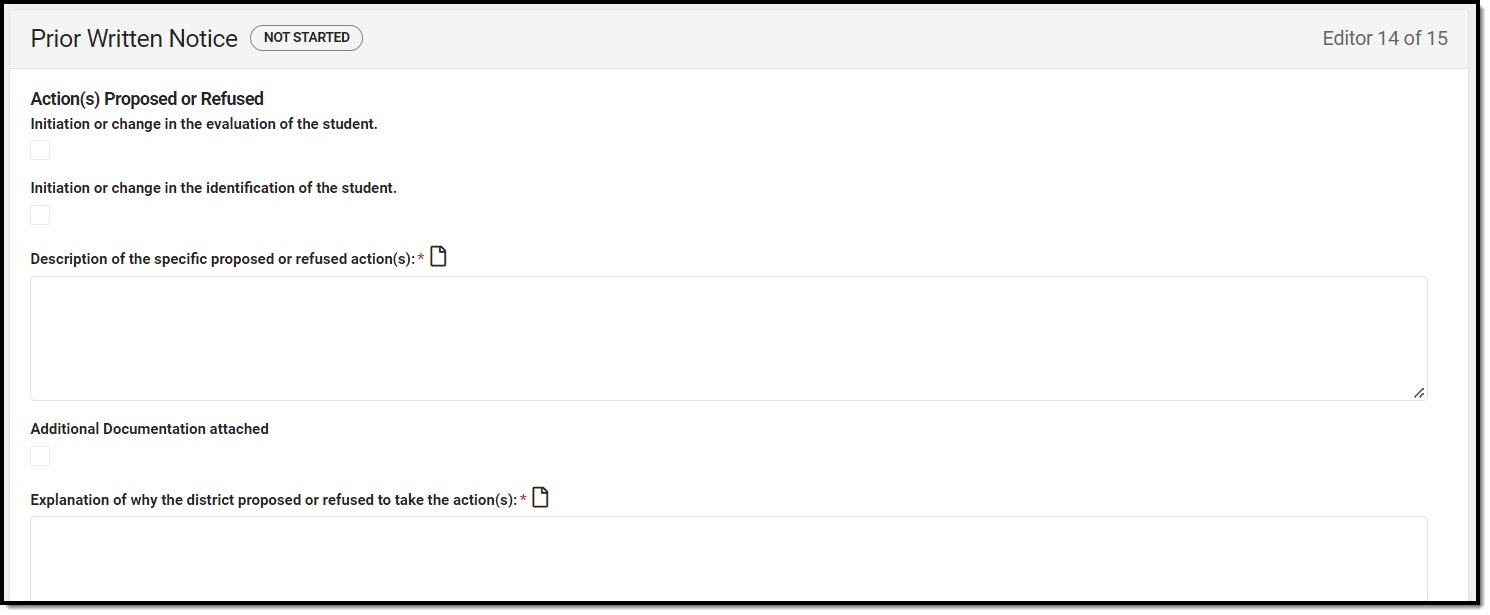 Prior Written Notice
Prior Written Notice
| Field | Description |
|---|---|
| Initiation or change in the evaluation of the student | Indicates an initiation or change in the evaluation of the student. |
| Initiation or change in the identification of the student | Indicates an initiation or change in the identification of the student. |
| Description of the specific proposed or refused action(s): Required | A description of the specific proposed or refused actions. |
| Additional Documentation attached | Indicates additional documentation is attached. |
| Explanation of why the district proposed or refused to take the action(s): Required | An explanation of why the district proposed or refused to take action. |
| Additional Documentation attached | Indicates additional documentation is attached. |
| Description of each evaluation procedure, assessment, record or report the district used as a basis for the proposal or refusal | A description of the procedures, assessment, record, or report used as a basis for the proposal or refusal. |
| Additional Documentation attached | Indicates additional documentation is attached. |
| Description of any other options the district considered and the reasons why those options were rejected: | A description of other options considered. |
| Additional Documentation attached | Indicates additional documentation is attached. |
| Description of other factors relevant to the district's proposal or refusal to take action | A description of other factors relevant to the proposal or refusal to take action. |
| Additional Documentation attached | Indicates additional documentation is attached. |
Evaluation Report Notes
The Evaluation Report Notes editor is used to document any additional notes related to the evaluation meeting.
 Evaluation Report Notes
Evaluation Report Notes
